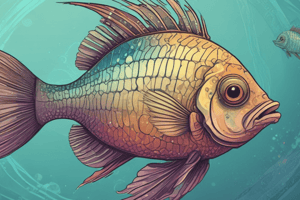Podcast
Questions and Answers
What can result from a lack of genetic diversity in fish populations?
What can result from a lack of genetic diversity in fish populations?
- Enhanced adaptability to environmental changes
- Increased genetic disorders (correct)
- Lower susceptibility to diseases
- Improved reproductive success
Which benefit does pedigree analysis provide in the management of fish populations?
Which benefit does pedigree analysis provide in the management of fish populations?
- Recognition of inbreeding and environmental impact (correct)
- Identification of potential outbreeding events
- Elimination of undesirable phenotypic traits
- Measurement of genetic drift over generations
What is the primary purpose of a marking system in cultured fish populations?
What is the primary purpose of a marking system in cultured fish populations?
- To promote higher inbreeding levels
- To ensure equal contributing genetic lines from both sexes
- To monitor and enhance genetic variability (correct)
- To facilitate controlled breeding among related individuals
Why should fish with poor constitution be culled in breeding programs?
Why should fish with poor constitution be culled in breeding programs?
What potential negative impact can arise from inbreeding in fish populations?
What potential negative impact can arise from inbreeding in fish populations?
What is a potential consequence of deleterious recessive alleles becoming expressed in homozygous individuals?
What is a potential consequence of deleterious recessive alleles becoming expressed in homozygous individuals?
Which breeding practice focuses on amplifying the influence of exceptional individuals within a population?
Which breeding practice focuses on amplifying the influence of exceptional individuals within a population?
How can inbreeding assist in genetic improvement?
How can inbreeding assist in genetic improvement?
What is a method to reduce inbreeding accumulation in hatcheries?
What is a method to reduce inbreeding accumulation in hatcheries?
In the context of inbreeding, what does creating purebred lines entail?
In the context of inbreeding, what does creating purebred lines entail?
Which of the following practices would NOT help in reducing inbreeding and maintaining genetic health?
Which of the following practices would NOT help in reducing inbreeding and maintaining genetic health?
What is a major benefit of inbreeding in agricultural settings?
What is a major benefit of inbreeding in agricultural settings?
How can the introduction of natural stocks benefit hatcheries?
How can the introduction of natural stocks benefit hatcheries?
What is the primary consequence of increased homozygosity due to inbreeding?
What is the primary consequence of increased homozygosity due to inbreeding?
Which term describes the reduction in fitness associated with inbreeding?
Which term describes the reduction in fitness associated with inbreeding?
Which of the following is NOT a strategy to reduce inbreeding accumulation?
Which of the following is NOT a strategy to reduce inbreeding accumulation?
What can be a significant drawback of inbreeding in a population?
What can be a significant drawback of inbreeding in a population?
How does inbreeding affect the frequency of heterozygous individuals in a population?
How does inbreeding affect the frequency of heterozygous individuals in a population?
What is one of the major risks associated with reduced genetic diversity in inbred populations?
What is one of the major risks associated with reduced genetic diversity in inbred populations?
What is the coefficient of inbreeding (F) used to measure?
What is the coefficient of inbreeding (F) used to measure?
What is a potential benefit of outbreeding compared to inbreeding?
What is a potential benefit of outbreeding compared to inbreeding?
What is a significant benefit of gene flow among populations?
What is a significant benefit of gene flow among populations?
What is one primary reason inbreeding is utilized in breeding programs?
What is one primary reason inbreeding is utilized in breeding programs?
Which of the following best describes inbreeding depression?
Which of the following best describes inbreeding depression?
What does a higher coefficient of inbreeding (F) indicate in a population?
What does a higher coefficient of inbreeding (F) indicate in a population?
Which strategy is least effective in preventing the accumulation of inbreeding in fish hatcheries?
Which strategy is least effective in preventing the accumulation of inbreeding in fish hatcheries?
In the context of genetic management, what is the potential issue of outbreeding?
In the context of genetic management, what is the potential issue of outbreeding?
Which factor contributes the most to increased genetic divergence among populations?
Which factor contributes the most to increased genetic divergence among populations?
What impact does inbreeding have on heterozygosity levels within a population?
What impact does inbreeding have on heterozygosity levels within a population?
Flashcards
Inbreeding
Inbreeding
The mating of closely related individuals, increasing the chance of offspring inheriting two identical copies of a gene.
Outbreeding
Outbreeding
The mating of unrelated individuals, increasing genetic diversity and reducing the chances of offspring inheriting harmful recessive genes.
Coefficient of Inbreeding (F)
Coefficient of Inbreeding (F)
A measure of how homozygous an individual is compared to the population average, calculated based on the relationship between parents.
Inbreeding Depression
Inbreeding Depression
Signup and view all the flashcards
Pedigree Analysis
Pedigree Analysis
Signup and view all the flashcards
Homozygous
Homozygous
Signup and view all the flashcards
Heterozygous
Heterozygous
Signup and view all the flashcards
Genetic Diversity Loss
Genetic Diversity Loss
Signup and view all the flashcards
Reduced genetic diversity
Reduced genetic diversity
Signup and view all the flashcards
Pedigree Analysis in Fish Populations
Pedigree Analysis in Fish Populations
Signup and view all the flashcards
Marking System in Fish Populations
Marking System in Fish Populations
Signup and view all the flashcards
Culling Fish with Poor Conditions
Culling Fish with Poor Conditions
Signup and view all the flashcards
Inbreeding in Fish Populations
Inbreeding in Fish Populations
Signup and view all the flashcards
Expression of deleterious recessive alleles
Expression of deleterious recessive alleles
Signup and view all the flashcards
Inbreeding in Research
Inbreeding in Research
Signup and view all the flashcards
Periodic replacement of brood stocks
Periodic replacement of brood stocks
Signup and view all the flashcards
Breeding stocks of different age groups
Breeding stocks of different age groups
Signup and view all the flashcards
Inducting natural stocks
Inducting natural stocks
Signup and view all the flashcards
Pedigree record maintenance
Pedigree record maintenance
Signup and view all the flashcards
What is inbreeding?
What is inbreeding?
Signup and view all the flashcards
What is inbreeding depression?
What is inbreeding depression?
Signup and view all the flashcards
What is gene flow?
What is gene flow?
Signup and view all the flashcards
How does gene flow counteract inbreeding?
How does gene flow counteract inbreeding?
Signup and view all the flashcards
Why might inbreeding be used in breeding programs?
Why might inbreeding be used in breeding programs?
Signup and view all the flashcards
What is outbreeding?
What is outbreeding?
Signup and view all the flashcards
What is outbreeding depression?
What is outbreeding depression?
Signup and view all the flashcards
What does the coefficient of inbreeding (F) measure?
What does the coefficient of inbreeding (F) measure?
Signup and view all the flashcards
Study Notes
Fish Genetics and Breeding: Inbreeding and Outbreeding
-
Inbreeding: Mating of related individuals, leading to offspring inheriting similar alleles from common ancestors. This includes: self-fertilization, brother-sister mating, parent-offspring mating, and cousin mating. Inbred offspring are more likely to inherit identical copies of the same allele.
-
Outbreeding: Mating of individuals from different populations or subspecies. It can cause a decline in reproductive fitness known as outbreeding depression.
Genetic Effects of Inbreeding
-
Increased Homozygosity: Increased likelihood of inheriting identical copies of a gene from both parents (identical by descent). This is measured by the inbreeding coefficient (F). A higher F value indicates a greater degree of homozygosity than the population average.
-
Inbreeding Depression: Negative impacts of inbreeding on fitness, including reduced survival, fertility, and susceptibility to diseases. It can lead to an increased frequency of harmful recessive genes.
Practical Applications of Inbreeding
- Breeding Stock Development: Inbreeding can concentrate desirable traits within a lineage, leading to new superior breeding stock.
- Creating Purebred Lines/Homozygous Populations: Inbreeding results in genetically homogeneous populations.
- Linebreeding: A milder form of inbreeding that amplifies the influence of exceptional individuals.
- Research: Inbred lines useful for experimental studies.
Reducing Inbreeding Accumulation
- Replacing Brood Stocks: Frequent replacement of brood stocks in hatcheries to prevent inbreeding.
- Exchanging Brood Stocks: Exchange between hatcheries helps diversify gene pool.
- Breeding Different Age Groups: Pairing brood stocks of different ages lowers odds of relatedness.
- Introducing Natural Stocks: Introduction of natural stocks enhances genetic diversity.
- Maintaining Pedigree Records: Accurate record keeping and tracking lineage to avoid closely related matings.
- Marking System: Proper marking for cultured populations improves record-keeping and avoids interbreeding.
Genetic Effects of Outbreeding
- Outbreeding Depression: Reduced fitness of offspring from mating individuals from different populations/subspecies.
Gene Flow
- Gene flow counteracts inbreeding effects by connecting populations genetically via gene exchange. More gene flow reduces population isolation and associated genetic divergence.
Learning Assessment
- Genetic Effects of Inbreeding: Increased homozygosity, expression of harmful recessive alleles (leading to genetic disorders).
- Definition of Inbreeding: Mating of closely related individuals, leading to increased homozygosity.
- Practical Application: Creating superior breeding stock, producing more desirable traits, creating inbred lines.
Studying That Suits You
Use AI to generate personalized quizzes and flashcards to suit your learning preferences.





